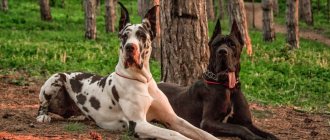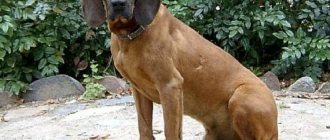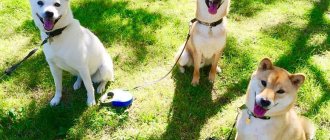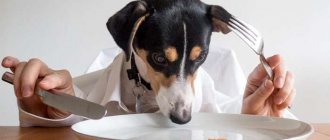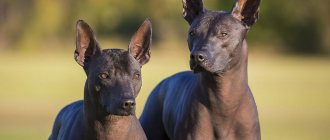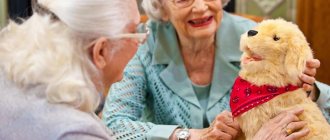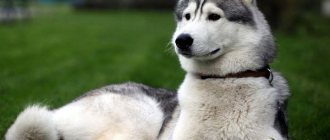03/09/2019 Drozd Nikolaevich Animals 6
Dog breeds with a flat muzzle are called brachycephalic in veterinary medicine. In such animals, the skull is modified as a result of artificial selection. Their muzzle is short and flat, which makes dogs susceptible to certain physiological problems related to breathing.
Peculiarities
Animals with this feature are called brachycephals. As a result of changes in the structure of the skull, the nostrils became narrow, and the palate, trachea and tear ducts became compressed. Physiological changes affected mainly the respiratory tract, so their health also became weaker. Dogs are sensitive to high temperature, stress, pain, and physical exertion. Any violation invariably leads to increased breathing.
The structural features of the larynx and trachea can lead to the development of oxygen deficiency and fainting. If your dog frequently loses consciousness, you should contact a veterinarian. Otherwise, an innocent symptom can lead to heart failure. However, the main health feature of flat-faced dogs is brachycephalic syndrome. This means that when hot air is inhaled, it does not have time to cool before entering the lungs and can lead to heat stroke.
Dogs with flattened faces scare novice dog owners with reverse sneezing. The pet often sucks in air, sniffles, wheezes and grunts. At the same time he freezes in a tense position. The cause of the phenomenon is dust or pollen, which irritates the mucous membrane in the nasal passage. Sometimes reverse sneezing is caused by an inflammatory process inside the body that develops after an infection.
The phenomenon itself does not pose a danger to life and health. This usually happens rarely, does not last long and goes away on its own. If you want to help your pet, then just cover the nostrils with your fingers so that the dog inhales through his mouth.
If attacks are repeated frequently or cause significant harm to the animal, then you should consult a specialist. Veterinarians advise filming reverse sneezing.
Terriers and related toy breeds
Terriers have served humans since ancient times; they are focused on cooperation and strong friendship with their owner. The name of the group itself translates as “earth”, “hole”. The dogs are designed for hunting small animals, foxes, badgers.
The breed group is not tall, so any Terrier can become a good apartment decorative pet. However, some of them are already accustomed to such a life, while others are obstinate and will not tolerate being treated like a toy.
Australian Silky Terrier
This breed is a typical representative of the Terrier family. The second name is Silky. Externally, the dogs are similar to Yorkies, but have a more elongated body, large rounded ears, and coarse light hair. The size of the animals does not exceed 26 cm at the withers and weigh no more than 6 kg.
The origin is vague, most likely, the dogs were bred in Australia by mixing Cairn and York terriers. Snares were used to protect barns and warehouses from unexpected guests and small rodents.
The dogs are friendly and peaceful, love children, wary but non-aggressive towards strangers . Australians are simply trained; they are happy to work with a person and benefit him. They get along well in an apartment, do not shed, do not emit odors, and are therefore hypoallergenic.
The most closely related breed of the Silky is the Australian Terrier. We recommend reading an interesting article about this breed: “Active and hardy Australian Terrier.”
Despite all the positive qualities, Silkies require a lot of attention. First of all, their long, hard coat requires cosmetic and hygiene procedures: daily combing, frequent bathing, regular haircuts. The pet also needs daily walks; without physical activity, the animal will become sad, bored and destroy the house.
Yorkshire Terrier
Another representative of decorative Terriers. Yorkies have long been accustomed to sleeping on soft pillows, eating from almost the same plate as their owner, and participating in exhibitions and competitions. You can’t appear at a social event without such a dog in your hands; any fashionable girl wants a furry friend like her.
Most likely, the dogs were bred in Scotland. There are two versions of origin:
- Pets were bred by miners in order to simplify the search for gas leaks;
- Yorkies were bred by farmers to protect their crops from rats and mice.
One way or another, animals have come a long way from hard work to social events.
Externally, Terriers are small, have 2 size varieties: mini (weigh up to 2 kg) , standard (from 2 to 3.5 kg) . Both pets are popular. In all other respects, they are absolutely similar: soft, long, silky wool of brown, black, gray or bronze colors; strong but elegant square body; erect small ears and round shiny eyes.
- The character of animals varies from individual to individual. In general, Yorkies are cheerful, active, playful, and loving. They are endlessly devoted to their owners and expect the same from them. Despite their size, these dogs contain at least a Sheepdog, capable of protecting an entire flock of sheep. Yorkshire terriers will guard the apartment from unwanted guests, they can be aggressive or distrustful of strangers, but they quickly get used to them if the owners so desire.
- Like Silkies, Yorkies are hypoallergenic (they don't shed), but their coats are more difficult to care for. Soft curls are constantly tangled. To prevent your hair from matting, you need to brush it 2-3 times a day. But you can choose any interesting haircut, then it will be easier to maintain skin hygiene.
Russian toy terrier
The Russian Toy Terrier is a descendant of the English Toy, the fruit of the work of Russian dog handlers. Unlike their brothers, Russian Toys were bred immediately for secular society. They did not clear the streets of rats, nor did they live from hand to mouth. The pets gained enormous popularity, because there were no such decorative dogs on the territory of the USSR.
Dogs have refined shapes, moderately developed muscles, and long limbs. Their height varies from 20 to 28 cm . The color can be brown (chocolate), black and tan, blue, purple. Based on the length of their coat, they are distinguished between smooth-haired and long-haired. Moreover, the latter were rejected for a long time and were not allowed for breeding. Their distinctive feature is the feathering on their ears and paws.
- The character of animals is ambiguous . On the one hand, they are devoted to their family, friendly and affectionate. However, their psyche is unstable. Any loud sound or sudden movement can cause an aggressive reaction or excessive timidity. In addition, Toys are jealous, they do not like it when their owners pay attention to someone else. For this reason, they do not particularly like children.
- This breed is easy to care for, although it is not hypoallergenic. Even long-haired individuals do not require frequent hygiene procedures. However, these Terriers are too fragile, they often get sick and suffer from physical injuries. They need to be treated with care.
Miniature Pinscher (Miniature Pinscher)
The breed is not directly related to Terriers, but belongs to the second group - Pinschers. But, in all likelihood, their ancestors were Manchester Terriers. The dogs are often called miniature Dobermans, and for good reason. Their genetic relationship affects not only the similarity of external qualities, but also the identity of temperament.
Miniature pinschers can be called decorative only because of their small size. At the withers they reach 25-30 cm and weigh about 6 kg. The dogs have strong, well-developed muscles and consistent proportions. The format is more square than elongated. The coat is short, hard, and lies tightly to the body. There are 2 colors: black and tan and red.
The peculiarity of the breed is its specific gait. Pinschers walk with their limbs raised high. This is reminiscent of the running of a riding horse, which is why Zwergs are sometimes called “the poor man’s pony.”
- The breed was created for service, so the character of the dogs is strong-willed and freedom-loving. Animals are used to search for drugs in customs services and to guard premises. But in the family, Pinchers are affectionate and reserved, they need personal space, but they also will not refuse love and tenderness. Children are treated normally, but only if the kids understand that dogs are not toys. They don't like strangers.
- Ideal for apartment living. Miniatures rarely shed and do not require special care. The only and most important point in the content is competent training and regular physical activity.
Varieties
Cute faces with a flattened nose evoke a lot of warm feelings in people. Let's look at which animals have this appearance - a complete list of breeds.
- Pug. Once upon a time, this dog was supposed to keep people warm. This explains the large number of fat folds. The nose did not play a special role in this case, so the selectors decided to deepen it. There is an opinion that pugs were loved by women as decorative dogs and were supposed to contrast with the appearance of the mistress. Smooth-haired representatives of the breed often develop brachycephalic syndrome; they snore quite loudly in their sleep and grunt when they increase physical activity.
- Bulldog French and English. It’s hard to imagine, but the breed was bred to participate in bull-baiting – fighting with bulls. Over time, the fun changed, and bulldogs began to participate in dog fights. The nose was always in danger during such activities, so the selectors carefully hid it. Moreover, the representatives of the breed themselves often ended fights by biting the enemy on the nose, as the weakest point.
- Pekingese. In China, such a dog was an indicator of the status of the owner. There, animals of this breed were bred in packs, and they were supposed to protect people. The nose was hidden to protect the pet. With such activities, the selectors paid more attention to the development of a powerful jaw and sharp teeth. Today, the small fluffy breed is used as a decorative one.
- Shar Pei. People from the southern province of China performed different tasks. Representatives of the breed were fighters and hunters, at the same time taking care of the herd and taking care of children. During selection, the nose was shortened and great emphasis was placed on the development of the jaw. A pinched nose allows the dog to tightly squeeze its prey in its jaws for a long time. This anatomical feature allows the animal to guard the victim for the required amount of time until the owner approaches. Particular attention should be paid to the dog’s breathing; under stress, it becomes much faster.
- Boxer. The dogs were bred by enthusiasts who dreamed of creating the perfect watchdog. There is an opinion that the name of the breed is due to the fact that in defense the animals actively use their forelimbs. The nose was deepened to increase the dog's safety during fights and external aggression.
- Dogue de Bordeaux. The large animal has excellent protective qualities and is able to stand up for both itself and its owner. The dog protects people, not territory, so it can live in an apartment.
SobakinoAbout dogs for people
Pekingese, pugs and bulldogs - all these dogs touch us with their appearance, and most importantly with their flattened nose. But behind the unusual appearance, big problems are usually hidden. And they all touch the snub nose. Why do dogs need it? Of course, sniffing and breathing are also the main indicators of canine health. But for some reason, in hunting breeds it is pushed much forward, but in these dogs it is driven into the very depths. Why did this happen?
You will never believe it, but these “buns-toys” were bred specifically for bullfighting - bull-baiting. This incomparable hulk of a bulldog, who is now snoring sweetly in your favorite chair, once fought a fight with a bull, ending it with a unique bite on the nose - the bull’s weakest point.
And so that their own nose was safe and sound and did not interfere with “working,” the breeders specially “moved” the nose deeper into the skull. Pekingese and pugs, of course, did not fight so excitingly, but their function was to protect the owner, and for this purpose the sharp teeth in the jaw pushed forward came to the fore. Brachycephals are the same snub noses that have long become wonderful fluffy “toys” in the modern world, all thanks to their unique appearance. But caring for them has its own subtleties, and here are some of them.
The most important nuance that any dog of these breeds can get is brachycephalic syndrome. Animals with this problem may suffer from heatstroke because their nose is too small and their neck is too short to quickly condition the hot air. The dog, inhaling hot currents of air over and over again, eventually overheats. Some airlines have even banned the carriage of brachycephalic dogs due to their high in-flight mortality rate.
Another feature of these cute “toys” is the folds around the nose, which endlessly become dirty with dust or food debris. Animals themselves cannot cope with this misfortune, so cleaning these very folds with cotton swabs should be a daily ritual. If there is not a lot of dirt, then dry cotton swabs will do. If your “piggy” has tried to acquire dirt, then the folds need to be treated with hydrogen peroxide and then wiped dry.
Those who have never encountered brachycephalics before may be frightened by the so-called “reverse sneezing” or “grunting”. At the same time, the dog often draws in air, as if suffocating. The thing is that the nasal passages are irritated by the smallest particles of dust and this causes such unusual sneezing. But if such “grunting” is repeated very often, then you should visit a veterinarian to rule out infection.
You can wait out single attacks, or you can help the dog by tickling it under the throat and relaxing the muscles. Closing the nostrils with your fingers works just as well. In this case, the animal will be forced to inhale through its mouth and the sneezing will immediately stop.
Another surprisingly endearing aspect of having a brachycephalic in your apartment is the loud, “juicy” snoring that can be heard not only by you, but also by numerous neighbors in the house.
Keeping puppies
All breeds with flattened muzzles were bred artificially; targeted selection reinforced the desired trait. The result was a modified shape of the skull, which entailed both positive and negative results. All breeds suffer from specific health problems and therefore require special care. The structural features of the respiratory tract make it difficult to inhale and exhale. Representatives of the breed may feel worse as a result of a congenital mutation that is not provided for by the standard.
Dogs can suffer from heart failure due to increased pulmonary artery pressure. It is important that one minor problem can lead to quite life-threatening diseases. The characteristics of the breeds must be treated carefully. Protect your dog from extreme heat, exercise, and stress.
If the heart rate increases, you should immediately calm the animal. In this condition, the body requires more oxygen. Air flows in only in limited quantities due to the narrow airways. As a result of prolonged stress, the animal may lose consciousness. If the animal is still small (up to 1.5 years), then it is worth protecting it from any stressful situations.
It is worth monitoring the weight of a dog with a flattened muzzle. If an animal is obese, it gets tired faster and feels worse in the heat. All this negatively affects breathing. Puppies should be fed on a schedule and in doses recommended for the dog's age. This rule is especially important for pugs, who have a very good appetite and do not like active games.
Choose the right collar so that it does not squeeze your throat. It is generally recommended to use a harness for walking. Do not make sudden jerks with the leash, which could result in choking, loss of consciousness, or even death. During hot summers, it is worth reducing the number of walks. Take your dog outside only early in the morning and in the evening when the air temperature drops.
Most brachycephalic breeds have folds near the nose. They themselves are not harmful, but require careful care. Regularly and carefully clean your skin of debris and food debris. For severe contamination, use a cotton swab with hydrogen peroxide and then wipe dry.
Special rules for keeping flat-faced dogs include a number of nuances.
- It is necessary to visit the veterinarian annually for consultation. The examination should include not only external diagnostics, but also an ultrasound of the heart, x-rays, examination of the larynx, and listening to the condition of the lungs and heart. Such measures will help detect diseases or pathologies in the early stages.
- It is worth contacting a specialist if the animal makes uncharacteristic sounds or has changed significantly in its habits.
- Regularly inspect the condition of the ears, eyes, folds near the nose and the respiratory canals themselves.
Brachycephalics cannot fly on an airplane - it is contraindicated for them. Changes in pressure, heat, stress can lead to the death of a pet. Moreover, it is quite hot on board an airplane, which also leads to heat stroke. If you are planning a trip, make sure you have someone at home to look after your dog.
A change in your usual environment and the absence of your beloved owners can also negatively affect your health.
Watch the video below for veterinarians' opinions on dogs with flat faces.
Dog breeds with a flat muzzle are called brachycephalic in veterinary medicine. In such animals, the skull is modified as a result of artificial selection. Their muzzle is short and flat, which makes dogs susceptible to certain physiological problems related to breathing.
Bichon Frize
- Height – up to 30 cm
- Weight – up to 6 kg
Belongs to a type of lapdog, the coat is thick and curly. The body is medium in size, the legs are short. By nature, the white Bichon Frize is an active, smart and friendly dog.
Pros:
- learn quickly.
Minuses:
- require special coat care;
- Need constant walks.
List of brachycephalics
Dogs referred to by this term include:
- bulldogs (French and English) - originally bred as fighting dogs;
- pugs - created to warm a person;
- Pekingese;
- Dogues de Bordeaux;
- bullmastiffs;
- Boxers are also fighting dogs;
- Shar-Pei;
- Japanese Chin;
- chihuahua;
- Pomeranian Spitz, etc.
These breeds were specially bred through selection work aimed at obtaining and consolidating the desired trait - a short, flattened muzzle. But, unfortunately, the dogs received many additional health problems.
The respiratory tract in dogs with a flat face has undergone changes: the nostrils have narrowed, the soft palate has enlarged, defects in the formation of cartilage tissue and the trachea are common, the lacrimal canaliculi are meek or folded. All pets of these breeds are forced to make efforts during the breathing process in order to take a normal breath.
What dogs are called brachycephalic?
The word "brachycephaly" literally means "short-headed," as the American College of Veterinary Surgeons explains. This term refers to dog breeds with flat faces. Popular brachycephalic breeds include: English and French bulldogs, bull mastiffs, Boston terriers, boxers, pugs, Shih Tsu, Lhasso Apso and Pekingese. The term can also be applied to mixed breed dogs that have inherited the trait from their brachycephalic ancestors. Brachycephalic dogs tend to have muzzles so short that they appear almost flat, which sets them apart from other breeds whose muzzles are simply somewhat shortened.
Brachycephalic syndrome
This is the name for narrowing of the airways, which is of clinical significance. In the dog’s body, the nostrils, nasal passages are narrowed, the soft palate, on the contrary, is elongated, the larynx and trachea are deformed. The result is severe shortness of breath and wheezing. Symptoms worsen in hot weather, stress, and physical activity. The condition can lead to a severe lack of oxygen and even cause the animal to faint.
In dogs of brachycephalic breeds, due to respiratory failure, pulmonary pressure is often increased and cardiac pathologies occur. Pulmonary edema and airway obstruction are often diagnosed in these animals and often lead to sudden death, the cause of which is suffocation.
Is there a way out? Some veterinarians resort to plastic surgery, after which the dog’s condition improves.
What are brachycephalic breed dogs?
Flat-faced dogs were specially bred by people through painstaking selection. According to one version, these dogs were intended for fighting with bulls, which they grabbed by the weakest and most unprotected place - the nose. But so that their own nose could breathe, it was removed closer to the skull. According to another much less militant theory, small short-faced dogs with flat noses resembled human babies in their appearance. Probably, when looking at them, the owners received aesthetic pleasure.
Simultaneously with the shortening of the muzzle, the animal's respiratory tract also underwent changes . A brachycephalic dog has narrowed nostrils, a disproportionately elongated soft palate with a protruding epiglottis that interferes with breathing, shortened or deformed (as if crushed and folded into an accordion) lacrimal canals, as well as various congenital pathologies of the trachea and larynx. All this makes even simple calm breathing quite difficult.
Along with the shortening of the muzzle, significant changes occurred in the dog’s nasal cavity.
When the ambient temperature changes (especially in summer, when it is hot), during emotional (stress, fear, intense joy, pain, etc.) and physical stress, brachycephalic dogs find it difficult to breathe. Severe shortness of breath begins, inhalations and exhalations are accompanied by whistling and wheezing, and there is a bubbling in the throat - this is how brachycephalic syndrome manifests itself. Respiratory activity becomes insufficient, therefore, little oxygen enters the body, oxygen starvation occurs and is often followed by fainting (loss of consciousness).
Subsequently, heart failure develops. Obstruction (obstruction) of the respiratory tract and pulmonary edema are often diagnosed, which lead to sudden death due to suffocation. Surgery to widen the nostrils and remove excess tissue from the roof of the mouth, as well as cutting out excess folds of the larynx, makes life much easier for your pet.
Brachycephalic dogs have difficulty breathing
In addition to breathing problems, brachycephalics have the following pathologies:
- Impaired outflow of tear fluid (excessive or insufficient hydration of the eyeball).
- Dental diseases. An incorrect bite provokes the formation of dental plaque, as well as inflammation of the gums (gingivitis).
- Dermatological diseases. Dirt and sebaceous deposits accumulate in the skin folds on the head; they provide a breeding ground for various fungi and bacteria.
- Problems with self-thermoregulation. Such dogs do not tolerate heat well . Their body temperature is often elevated.
- Allergic manifestations (dermatitis). Many brachycephalic dogs are allergic (to food, pollen, household chemicals, etc.).
- Excess body weight. Short-faced dogs are often prone to obesity.
Video: brachycephalic dogs
What should you pay attention to?
The owner of a dog with a flat face should be aware of:
- How a dog breathes in the heat. Respiratory failure combined with overheating is a dangerous sign that can lead to irreparable consequences and even death.
- Do the animal's nostrils stick together when inhaling?
- Does the dog make sounds or groans when breathing?
- If your pet constantly snorts, sneezes, puffs, this is abnormal.
- While wearing a collar, the dog begins to cough. There is no point in causing suffering to your pet once again, but it is better to walk your dog on a harness.
- It is worth monitoring the animal’s weight and not allowing it to gain extra pounds.
Main symptoms
The most striking symptoms are diagnosed at the age of 3-4 years. It includes the following features:
- problems with the gastrointestinal tract (excessive salivation, increased gas formation and vomiting of undigested pieces of food);
- chronic snoring, which occurs not only during sleep, but also at rest;
- periodic fainting due to overheating or hypoxia (occurs when walking in hot weather, during or immediately after physical activity);
- blue or pale mucous membranes.
BCS, which affects the quality of life, requires mandatory treatment. Otherwise, the animal may develop serious complications that can be fatal.
Signs that require urgent veterinary attention
If the dog has a flat face, the owner should be constantly alert. Here are signs that require urgent attention to a veterinarian:
- loud wheezing when breathing;
- unnatural posture of the animal;
- rapid breathing;
- animal anxiety;
- pale or blue tongue, lips and gums;
- foam coming out of the mouth.
In all these cases, you should not give the dog water or medicine; you should provide air flow and urgently take the animal to the doctor.
Other possible health problems
In addition to respiratory pathologies, dogs with a flat face also have other pathologies:
- Disturbances in the outflow of tear fluid. It happens that the eyes of such dogs constantly get wet. It may also be the other way around - the eyeball is not sufficiently moistened, especially if the organs of vision are enlarged.
- Dental diseases. Brachycephalics often have an incorrect bite, which is why plaque, tartar, and gingivitis appear.
- Excessive wrinkles on the face lead to the spread of fungal infection.
- Thermoregulation problems. Brachycephalics often suffer from excessive body temperature.
- Allergic reactions are by no means uncommon in dogs of the breeds in question. They manifest themselves in the form of skin rashes, as well as respiratory spasms.
- Tendency to gain excess weight. Dogs of brachycephalic breeds should not be overfed; excess weight can significantly worsen their health.
Brussels Griffon
- Height – up to 28 cm
- Weight – up to 5 kg
First appeared in Belgium, all varieties have hard, short hair, color - tan, red. Distinctive features of the Brussels Griffon are intelligence, liveliness, and an unusual muzzle.
Pros:
- learn quickly;
- love children and other animals.
Minuses:
- often suffer from eye diseases.
Reverse sneezing
This phenomenon is often observed in brachycephalic dogs. It looks like this. The dog spreads its front legs, tenses, and makes a series of snorting sounds for a minute. After the attack he behaves as usual. It could also be different: the dog inhales, makes a loud sound and freezes, stretching his neck.
Such sneezing can be caused by strong odors, emotional reactions, and dust getting into the nose. It is not a pathology, and its features are caused by the specific structure of the muzzle. But such a phenomenon should be distinguished from brachycephalic syndrome, and therefore it makes sense to film the attack and show it to the veterinarian. As a rule, no additional measures are required during an attack; the sneezing goes away on its own.
Air travel ban
Owners of the dogs in question may be faced with the fact that their pet will not be taken on board the plane, and will also not be allowed into a special compartment for transporting animals. This is due to the frequent death of such animals during flight. Stress and changes in pressure trigger the mechanism of acute respiratory failure in a dog. Therefore, you should not be upset because of the ban, but it is better not to risk the life of the animal and leave it with relatives or friends for a couple of weeks. This way you can save the dog's life.
Let's take a closer look at some brachycephalic dog breeds and their characteristics.
Japanese Chin
- Height – up to 25 cm
- Weight – up to 4 kg
The Japanese breed, the ancestor of the Tibetan spaniels, was created as a gift to the emperor. The pet has long, thick hair, color – white and black. The Japanese Chin has a small muzzle, large eyes, and ears with long hair. By nature, they are self-sufficient, confident, playful and stubborn pets.
Pros:
- have good health;
- You can't go for walks often.
Minuses:
- can be aggressive and touchy;
- difficult to train.
Pekingese
A breed considered sacred in Ancient China. It is suitable for an inexperienced breeder, but families with small children should not take the dog, as the child can injure the animal.
Pekingese puppies are almost impossible to train due to their stubborn nature. The dog barks often, and for no apparent reason. This feature is also worth considering, especially if you decide to get a Pekingese puppy in an ordinary city apartment.
The advantages of the breed are longevity and cleanliness. Difficulties include caring for the coat and difficulty getting along with family members and other animals.
Australian Silky Terrier (Silky Terrier)
- Height – 25 cm
- Weight – 7 kg
First appeared in Australia, now especially popular in England. The body of the dog is medium in size, the coat is long and silky, the color is fawn. The Australian Silky Terrier quickly becomes attached to its owner, can be a hunter of small animals, and is distinguished by its calmness.
Pros:
- clean breed;
- feels good in the apartment.
Minuses:
- requires constant grooming.
Pugs
This small, flat-faced dog is a sweet, low-maintenance pet. The pet spends most of its time sleeping. The dog is sociable, playful, loyal to its owner, but sometimes stubborn. You can have a pug in the family. where there are small children. The dog is loyal to children's pranks, sometimes turning into a cute soft toy.
Caring for a pet is easy. It is important to wipe the fur daily; the pug’s eyes are treated with a cotton swab dipped in tea leaves. The nasal folds are treated with cotton pads soaked in alcohol-free baby lotion. You can bathe your dog 1-2 times a month.
Transporting dogs with flat faces (brachiocephalic breeds)
Delivers animals with flat faces.
| Route | Transportation method | Price |
| Moscow, Moscow Region, Moscow - another city | plane, train, car | Look |
Hello dear visitor. We are pleased to welcome you to our website and today’s article will be devoted to the topic of transporting dogs and cats with flat faces on an airplane. So, let's start looking at this question in order:
As sad as it may be, starting from December 1, 2021, airlines introduced a complete ban on the transportation of brachiocephalic dogs, i.e. those breeds that have a shortened muzzle. These breeds include quite popular and widespread breeds, such as pugs, all varieties of bulldogs, Brussels griffins, Shih Tzus, boxers and other rarer breeds. The airline justifies its decision by the fact that these dog breeds, due to the structure of the skull, have difficulty breathing. According to the airline, this situation can be dangerous for the animal itself during the flight and can even lead to death. We do not undertake to judge the ban on transportation adopted by the airline, but our many years of experience in delivering dogs with flat faces does not in any way agree with this decision of Aeroflot. In our more than 10 years of transportation practice, there has not been a single case where the brachycephalic dogs we delivered did not reach their destination in full health.- However, a little later, probably under the pressure of numerous angry letters to Aeroflot from breeders of animals of brachycephalic breeds, the airline somewhat weakened its 100% ban and, subject to certain requirements, still carries brachycephalic animals.
Let's list below the airline's conditions, compliance with which still allows transportation:
- Transporting dogs with flat faces is possible, but only in the CARGO way, i.e. in the status of unaccompanied cargo, with the animal being registered for the flight through the cargo terminal and, as a rule, with the involvement of a cargo broker. The airline still prohibits transporting a dog accompanied by a person, as hand luggage (up to 8 kg) or as personal luggage.
- When sending an animal to CARGO, the airline requires a letter of guarantee from the sender stating that he will have no claims against it if the animal dies during the flight, and will also pay all costs for returning the animal back. As a comment, we can reassure you, dear reader. Of course, the airline will create comfortable heated conditions for CARGO transportation, but by requiring this letter of guarantee, it is simply insuring itself in case of litigation with the client.
- The transport box for the transported animal, in size, should be slightly larger than the standards that are applicable for dogs of non-brachiocephalic breeds.
- The last point of the airline's requirements is that the sending freight brokerage company must have an employee on staff who has completed special IATA courses on organizing the transportation of live cargo. To the letter of guarantee from item “B” listed in the list, you must attach a scan of a diploma of completed IATA courses. By the way, it should be noted that here the circle of possible freight brokers is significantly narrowed, since training in these courses is very expensive. However, an employee of our company has a diploma from IATA and we freely ship flat-faced animals both throughout Russia and around the world.
Dear reader, now you have complete information on the topic of transporting brachycephalic animals and if you need our help in delivering your pet, then contact us by any means of communication indicated on the Contacts page.
French Bulldog
This breed is a smaller version of the English Bulldog. The dog is muscular, initially it was bred to participate in battles, but later it was classified as an ornamental breed. By nature, the pet is cheerful and cheerful.
Features of the French Bulldog breed are:
- Calm disposition, lack of fear.
- They cannot stand loneliness and need constant communication with their owner.
- Requires minimal grooming (hair brushing and infrequent washing).
- Stubbornness, due to which one should not expect success in training.
Russian toy terrier
- Height – up to 28 cm
- Weight – about 3 kg
It can be long-haired or short-haired; it appeared on the territory of Russia. The dog's body is small, its paws are thin and sinewy. Coat color – tan, fawn, black with shades of brown. By nature, Russian toy terriers are active, fearless dogs, devoted to their family.
Pros:
- require almost no grooming;
- get along easily with children.
Minuses:
- some dogs require strictness and training;
- have an unstable psyche and are easily exposed to stress.
Dogue de Bordeaux
This is a large animal with long hair. These dogs are also called French Mastiffs. The animal looks scary, but has a calm disposition. They have a well-developed intellect and excellent memory.
Breed Features:
- Excellent security qualities.
- I am ready to stand up for my own people to the death.
- It can show aggression towards “strangers”, but more often it frightens by barking. He can throw it only as a response.
- They get along well with other dogs, but are intolerant of other people's pets and can be aggressive.
The dog is intended to protect family members, and not the local area, so it can easily live in an apartment, but it is worth considering its rather large size.
Grooming includes combing the fur, trimming the claws, and regularly examining the eyes and ears. Frequent bathing is not required; the procedure can be replaced with dry cleaning.
Miniature Pinscher (Miniature Pinscher)
- Height – up to 30 cm
- Weight – up to 4 kg
Decorative dog, the coat is short and smooth, the color is red and tan. Miniature Pinschers have a slender body with strong paws. The characteristics of the breed are energy, sharp intelligence, activity and curiosity.
Pros:
- cautious towards strangers;
- may be a hunter.
Minuses:
- In winter you need to dress your dog in overalls, it freezes quickly.
